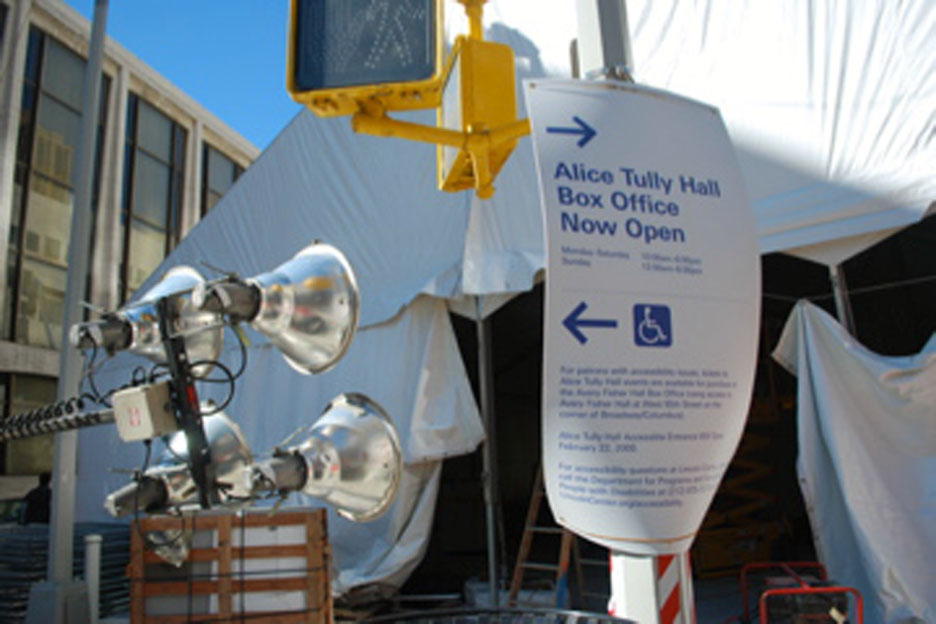After Latest Renovation of Lincoln Center, Alice Tully Hall Opens to a Warm Reception
After 22 Months, the New Lincoln Center Hall is Now Open to the Public
June 12, 2011

Published: February 26, 2009
On Feb. 22, at the start of its “Opening Nights Festival,” Lincoln Center for Performing Arts unveiled its latest completed construction project, the modification of Alice Tully Hall, one of the series of projects throughout the Juilliard and Lincoln Center campuses.
The concert hall was founded by philanthropist Alice Tully and was first opened on her birthday on Sept. 11, 1969. It was the first major New York City concert hall designed for chamber music. Now nearing the 50-year anniversary in May of this year, a transformation was crucial, according to Reynold Levy, president of the Lincoln Center for Performing Arts, Inc.
“We are now preparing Lincoln Center for the 21st century,” Levy said in a press preview at Tully Hall on Feb. 19.
This ambitious task has taken the efforts of many. Hundreds of staff members and volunteers, the architectural vision of the Diller, Scofidio and Renfro firm, FXFOWLE Architects and over $600 million in public and private funding have combined to create this new, state-of-the-art performance space.
“This has been an amazing team effort,” said the appreciative Elizabeth Diller, main architect and partner of Diller, Scofidio and Renfro.
The firm’s personal vision to create a more inviting and friendly space is immediately realized from Tully Hall’s entrance on Broadway. The building, once a stoic and bleak block of white with shaded windows, now has a façade of contemporary-styled glass. The stairs, inlaid from the street level, as well as the bare lobby, create a sweeping effect as you walk into the building. Both features are sure to interest street voyeurs and passersby.
“We wanted fusion between the audience and general public,” Diller said.
Inside Tully Hall, the changes are also evident. The box office has expanded and a new café was added, but perhaps the biggest and most impressive changes can be found at the heart of Tully Hall—the Starr Theatre.
In 2006, the year Tully Hall closed for renovations, the Starr Theatre was home to over 700 performances sponsored by various arts groups such as the Juilliard School, the Film Society of Lincoln Center, the Chamber Music Society of Lincoln Center and Lincoln Center for the Performing Arts, Inc. It has featured New York Recital Debuts from artists such as Thomas Quastoff, Bryn Terfel and Joshua Bell.
In an effort to create a more inviting space for performers, the architects focused on combining arts and science. The building not only has the acoustics which transfer a louder and more full sound throughout the hall, but it also blocks out noise congestion from the 66th Street subway station, located just under and outside the hall. Smooth African veneer-wood covers the floor, walls and ceiling, replacing old hardwood. This seems like an unnecessary trade-off, but the veneers allow 360-degree moveable wall panels and a glowing blush which illuminates before each performance, just as the chandeliers lower and rise in the Metropolitan Opera.
All in all, the completed project seems to suggest a desire to consider Alice Tully Hall as one of the world’s premiere concert halls.
“It is a complete transformation. It brings a new level of openness, immediacy and transparency,” Levy said. “Never will anyone ask the question, ‘Where is Alice Tully Hall?’”
To celebrate the new transformations, Lincoln Center for Performing Arts, Inc. will feature an Opening Night Festival from Feb. 22 to March 8. Featured acts will include the London Philharmonic, Blecea Quartet, Jordi Savall and many others. There will also be four free performances, as well as ticketed events, starting around $25.









